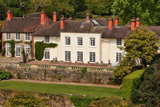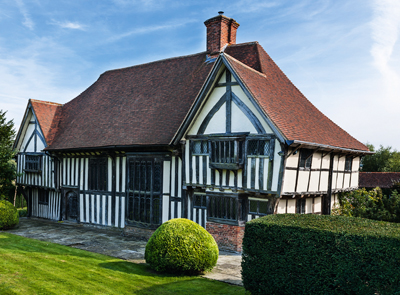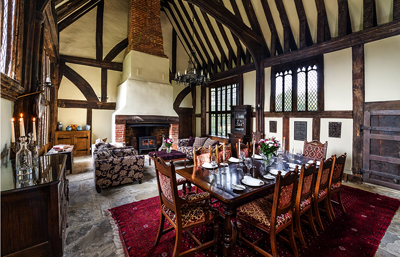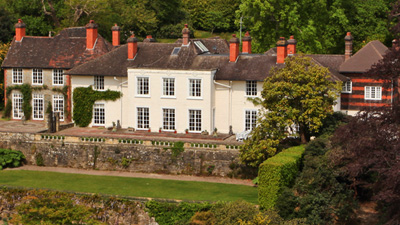Country houses fit for kings
Two country houses for sale in Kent and East Sussex are likely to tempt would-be buyers in the south east


The weight of history sits lightly on the shoulders of tranquil, Grade I-listed Dukes Place at West Peckham, Kent, which was first built in the early 1400s, burnt down and rebuilt a century later, converted into labourers' cottages in the 18th century, rescued from semi-dereliction after the Second World War and beautifully restored as a single-family house in recent years. Set in almost five acres of grounds that include lovely formal gardens designed by Chelsea Gold Medal winner Roger Platts, pristine Dukes Place comes fresh to the early spring market at a guide price of £3.595 million, through the Sevenoaks office of Hamptons International (01732 280801).

Dukes Place, £3.595m, Hamptons International
Dukes Place was originally part of West Peckham Manor, owned before the Conquest by King Harold's brother, Leofine, who died beside the king at the battle of Hastings. The manor, valued at eight pounds in the Domesday survey, was given by William the Conqueror to his half-brother, Odo, Bishop of Bayeux, whom he also made Earl of Kent.
In about 1330, the manor was divided into two, with one half going to Lionel, Duke of Clarence (third son of Edward III), after whom, presumably, it was later renamed Dukes Place. Forty years later, the property passed to the Culpeppers of nearby Oxen Hoath and remained in their possession until, in 1408, Sir John Culpepper, one of Henry V's knights, donated it to the Knights Hospitallers of St John of Jerusalem, a powerful medieval Christian military order, whose ranks were filled with the members of Europe's richest families.
The order founded a preceptory, or commandery, at Dukes Place, where hospitality was dispensed to returning pilgrims until the dissolution of the monasteries saw the house and its lands returned to Crown ownership. Dukes Place sits quietly on the edge of pretty West Peckham village, an oasis of calm with a beautiful Saxon church (and a renowned gastropub, The Swan on the Green) in a lovely wooded part of Kent, 11 miles from the busy commuter hub of Sevenoaks. Yet, despite numerous alterations and additions made to the house by successive owners in the 16th, 17th and 18th centuries (when it was converted into seven workers' cottages), and again during restoration in the 20th and 21st centuries, the building has somehow retained the integrity, charm and spirituality of the Hospitallers' original Wealden hall house.

The Great Hall at Duke's Place
Technology and craftsmanship blend seamlessly to create a series of free-flowing reception rooms: the drawing room, with its original stone fireplace; the dining room, with its inglenook and wood-burning stove; the study and library, with handcrafted oak joinery fitted by Icklesham of Hastings; and the splendid Great Hall with its tripleheight ceiling, crown post and original 15th-century oak doors. And-a rarity in a house of its age and listing-each of the five first-floor bedrooms has its own bath or shower room.
Sign up for the Country Life Newsletter
Exquisite houses, the beauty of Nature, and how to get the most from your life, straight to your inbox.
Current owner Neil Robins has completed the transformation of Dukes Place from a house of history to a contemporary family home by converting traditional outbuildings into a splendid entertainment complex and a two-bedroom cottage to complement the tennis court and swimming pool. Mr Robins is fulsome in his praise of the restoration of the main house carried out by the previous owner some 10 years ago and future owners will enjoy not only the facilities he has created, but also the wonderful gardens laid out by Roger Platts, which have finally begun to reach maturity.
The recent sunny spell has been a massive shot in the arm for the countryhouse market in the Garden of England, which is still probably 15 months away from a sustained recovery, says Andrew Harwood of Knight Frank in Tunbridge Wells. In the meantime, he is testing the water with the launch onto the open market of imposing South Hartfield House, with 35 acres of gardens, woodland and paddocks, across the county border near Forest Row, East Sussex. Knight Frank (01892 515035) quote a guide price of £5.75m for the impressive, 11,700sq ft house, which stands on the northern edge of the uncrowded Ashdown Forest-a former royal hunting park-and has some interesting royal connections of its own.

South Hartfield House, £5.75m, Knight Frank
Although the house is unlisted, it's thought to date from the 1760s, with extensions carried out in about 1820 and again later. During the 19th century, one of the Wedgwood sisters is thought to have lived at South Hartfield House and Charles Darwin, who was closely related to the family, both by blood and by marriage, was a frequent visitor. The house was later rented by Fruity Metcalfe, an Indian army officer and a close friend and equerry of Edward VIII. Following the Abdication, the Duke and Duchess of Windsor are understood to have stayed there after the war.
Other illustrious residents of Hartfield include Gen Sir Reginald Hildyard, who died there in 1965, aged 88. The village itself dates from Saxon times, but perhaps its main claim to fame came in 1924, when A. A. Milne moved to the village with his son, Christopher Robin, and built a bridge over a stream on his farm, where the historic game of Pooh Sticks was invented. South Hartfield House was in ‘a terrible state' when the current owners bought it in the mid-1990s and it has taken a huge amount of work to bring the house up to its present high standard of comfort and elegance, Mr Harwood reveals. Approached through electric wrought-iron gates along a drive bordered by wellingtonias, cedars, azaleas and rhododendrons, the house boasts a grand reception hall with oak floors, oak panelling and a beamed ceiling, leading to the three main reception rooms, all of which overlook the gardens towards the Ashdown Forest.
With five bedroom suites, two further bedrooms and a separate five-bedroom wing, the arrival of an unexpected guest is unlikely to be a problem at South Hartfield House.
Country Life is unlike any other magazine: the only glossy weekly on the newsstand and the only magazine that has been guest-edited by HRH The King not once, but twice. It is a celebration of modern rural life and all its diverse joys and pleasures — that was first published in Queen Victoria's Diamond Jubilee year. Our eclectic mixture of witty and informative content — from the most up-to-date property news and commentary and a coveted glimpse inside some of the UK's best houses and gardens, to gardening, the arts and interior design, written by experts in their field — still cannot be found in print or online, anywhere else.
-
 Why British designers dream up the most desirable hotels
Why British designers dream up the most desirable hotelsWhen it comes to hotel design, the Brits do it best, says Giles Kime.
By Giles Kime Published
-
 The five minute guide to 'The Great Gatsby', a century on from its publication
The five minute guide to 'The Great Gatsby', a century on from its publication'The Great Gatsby' sold poorly the year it was published, but, in the following century, it went on to become a cornerstone of world literature.
By Carla Passino Published
